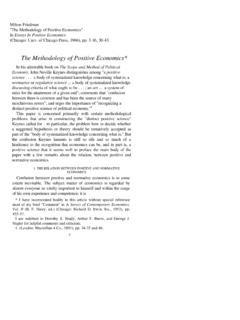Transcription of Mathematical Modeling in Agricultural Economics
1 Mathematical MODELS IN Economics Vol. II - Mathematical Modeling in Agricultural Economics - Richard E. Just Mathematical Modeling IN Agricultural . Economics . Richard E. Just University of Maryland, USA. Keywords: Agriculture, Consumer theory, Econometrics, Game theory, Mathematical programming, Mechanism design, Microeconomics, Producer theory, Welfare Economics . Contents 1. Introduction: The Pioneering Role of Agricultural Economics in Mathematical TE SS. Modeling S. 2. Simulation Models and Normative Modeling Linear Programming R. AP L. Integer Programming Quadratic and Risk Programming H O. Nonlinear Programming Stochastic and Chance-Constrained Programming C E. Dynamic Programming and Control Theory Multiobjective Programming, Calibration, and Other Pragmatic Adaptations E O . 3. Econometric Models and Positive Modeling Linear Regression Analysis Panel Data Analysis Nonlinear Regression PL C.
2 Simultaneous Equations Estimation Qualitative Econometric Models M ES. Time Series Analysis Nonparametric Data Analysis and Data Envelopment Analysis Data Availability SA N. 4. Theoretical Models Producer Theory U. Consumer Theory Investment and Intertemporal Behavior Anomalies, Hysteresis, and Experimental Economics Market Equilibrium and International Trade Computable General Equilibrium Models Industrial Organization and Noncompetitive Behavior Welfare Economics and Applied Policy Analysis Expectations and Information Game Theory, Mechanism Design, and Principal-Agent Models 5. The Impact of Mathematical Models in Agricultural Economics Glossary Bibliography Biographical Sketch Summary Encyclopedia of Life Support Systems (EOLSS). Mathematical MODELS IN Economics Vol. II - Mathematical Modeling in Agricultural Economics - Richard E. Just The discipline of Agricultural Economics has played a pioneering role in the application of Mathematical models in Economics .
3 Originally, farm management specialists developed enterprise budgets to help farmers identify their best farming activities. These budgets, which specified the amounts of inputs required and outputs generated by allocating a unit of land to various crop or livestock production activities, facilitated the application of Mathematical programming techniques as they were developed to offer normative advice to farmers. Eventually, programming models were expanded to offer advice at regional and national levels on issues as diverse as commercial Agricultural policy, environmental policy, water and soil conservation policy, and public investment in infrastructure such as waterway and irrigation development. Agriculture was a natural application of stochastic and dynamic programming because of the stochastic nature of production and prices and the dynamic issues of capital investment and grain stock TE SS.
4 Accumulation. S. On another front, Agricultural Economics played a key role in the development and R. application of econometrics for positive Modeling purposes. With a wide variety of AP L. reasonably competitive product markets and abundant public data, agriculture presented H O. a ready field of application for various statistical regression techniques as they were developed. Simultaneous equation models were easily expanded to address issues of C E. international trade as they became important. In many cases, Agricultural production characteristics such as heterogeneity, imperfect anticipation of product prices, and E O . production risk motivated development and refinement of econometric techniques. With perceived competitive conditions, agriculture served as a ready laboratory for application of techniques that increasingly incorporated microeconomic theory in model specification, first with primal and then with dual approaches.
5 In more recent times, as PL C. contracting has replaced open market transactions, agriculture has become a ready laboratory for application of game theory and the principal-agent models of mechanism M ES. design that now dominate microeconomic analysis. 1. Introduction: The Pioneering Role of Agricultural Economics in Mathematical Modeling SA N. U. The discipline of Agricultural Economics has played a pioneering role in the application of Mathematical models in Economics . The discipline began with the study of farm management in the nineteenth century, when a majority of all families were involved in some form of farming. In the United States, The Morrill Act of 1862 set up land grant colleges and was soon followed by the Hatch Act of 1887, which set up Agricultural experiment stations connected with land grant colleges. This led to the development of academic disciplines including Agricultural Economics , and research efforts intended to improve productivity and management of family farms.
6 Later, the Smith-Lever Act of 1914 set up cooperative extension services attached to these institutions of higher learning, which had the purpose of extending new research knowledge to farmers to promote its early implementation. This system of combining teaching, research, and extension in institutions of higher learning was so successful that it has been emulated throughout the world. Encyclopedia of Life Support Systems (EOLSS). Mathematical MODELS IN Economics Vol. II - Mathematical Modeling in Agricultural Economics - Richard E. Just Early research in Agricultural Economics in these institutions focused on farm management. Enterprise budgets were developed that offered farmers guidelines on input use and costs as well as average output quantities and revenue associated with allocating a unit of land to alternative crop or livestock production activities using production practices prescribed by the production sciences.
7 When linear programming became practical in the 1950s and 1960s with the growth of computing power, these enterprise budgets provided the data necessary to implement this new optimization tool. Further, the large number of alternative farming production activities and the wide variety of constraints associated with land, labor, capital, and machinery capacity made farming a useful demonstration of the tool. Agricultural economists applied programming tools widely, readily adopting and in some cases innovating subsequent generalizations associated with quadratic and nonlinear functions representing risk, non- continuous decision variables, stochastic constraints, and multiple objective criteria. TE SS. Owing heavily to Earl O. Heady at Iowa State University, a major land grant institution, programming models were expanded during the 1960s from the farm level to various S.
8 Regional levels with activities and constraints numbering in the thousands. R. AP L. After the initial focus on farm management, the discipline expanded to study marketing H O. with the intent of improving farmers' well-being by more effective purchasing of inputs and selling of outputs. Accordingly, the name of the discipline was changed from farm C E. management to Agricultural Economics . Because the markets for grains and livestock are so interrelated, this led to Modeling market supplies and demands as systems of E O . equations, and to the need for estimating those systems. At the same time, Agricultural production economists recognized that the budgets based on production scientists'. notions of optimality were based more on maximizing physical output rather than maximizing farmers' profits. This led to estimation of production functions specifying PL C.
9 Output quantities as functions of factor input levels and other characteristics of the production environment including human capital. From these, Agricultural economists M ES. determined profit maximizing input and output levels and their response to changes in prices and technology. These studies were both normative (prescribing optimal choices). and positive (reflecting actual behavior). The study of farm management thus grew into SA N. the study of production Economics . U. The need to estimate relationships in both production and marketing led to the application of statistical methods in Economics , now called econometrics. One of the early efforts occurred in the 1930s when the California land grant college at Berkeley (now the University of California) hired a young psychometrician, George M. Kuznets. He and colleague Ivan M. Lee were soon training the likes of Lawrence R.
10 Klein, Arnold Zellner, Zvi Griliches, and Yair Mundlak, who were early leaders in the development of econometrics. Arnold Zellner was either inventor or co-inventor of two of the three most common multiple-equation estimation methods (three-stage least squares and seemingly unrelated regression). Together with the development of time series techniques, huge econometric models were developed in the 1970s and implemented commercially with the intent of predicting prices and quantities in Agricultural markets. As estimation techniques were perfected and computer capacity was expanded, and as agriculture was heavily regulated following the depression politics of the 1930s, the Encyclopedia of Life Support Systems (EOLSS). Mathematical MODELS IN Economics Vol. II - Mathematical Modeling in Agricultural Economics - Richard E. Just study of Agricultural policy became an important sub-discipline in Agricultural Economics .















